Grade 4 Science Discussions 2011-2012
Classroom Discourse Findings
Our analysis showed some kinds of talk moves were already part of the teachers’ practice, as seen in their use of talk moves in guiding pre-discussions (see Figure 1). Further, five of the six teachers from whom we have pre-post data used more academically productive talk moves (APT moves) in the post- discussions than in the pre- discussions. (see Figure 1). There was also considerable variation in teachers’ use of talk moves to orchestrate classroom talk in pre-and post-discussions.
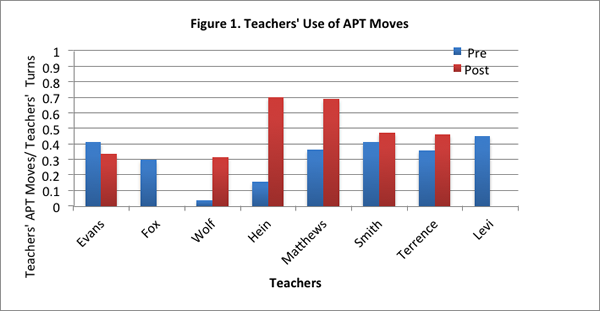
A closer examination of teachers’ use of APT moves revealed that the greatest increase in the use of moves across the six teachers (pre-post data) occurred with respect to the Dig Deeper Moves (Press for Reasoning/Why; Challenge moves). For example, “Why do you think it’s important to have the same type of container and the same size of container? Why do you think that’s important?” (see Figure 2; the data are calculated as proportion of different types of APT moves used from the total number of APT moves used by the teachers). Figure 2 shows that approximately 8% of the total APT moves used involved Dig Deeper moves in the pre discussions, whereas approximately 32% of the total APT moves used in the post-discussions were Dig Deeper moves.
Further, in the pre-discussions, the teachers did not use any listening moves, whereas the listening moves accounted for 7.77% of all APT moves used in the post-discussions. For example, “Can someone repeat what Avery said in their own words? [9 second pause] Grace, give it a try.”
On the contrary, there was a remarkable decrease in teachers’ use of Think With Others moves, which accounted for 12.62% of APT moves used in the post-discussions, as opposed to 35.44% of the APT moves used in the pre-discussions.
(Add On; Who can Explain; Do you Agree/Disagree). For example, “No way to know for sure. Okay. Okay. Anyone want to add anything to that or disagree with that or anything?”)
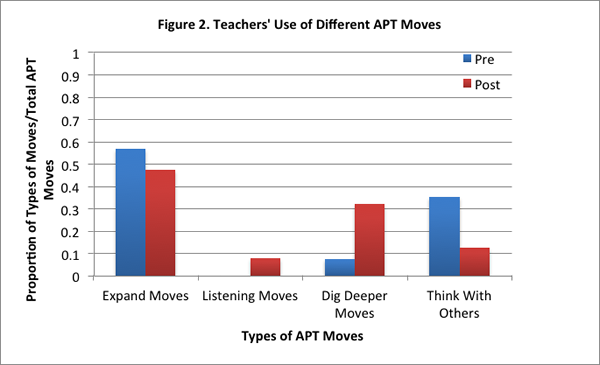
Our analysis of students’ talk indicated that they made attempts at co-constructing ideas with their peers in the pre-discussions (see Figure 3). Of the six teachers’ classes, students in two classes made more co-construction attempts in the post-discussions.
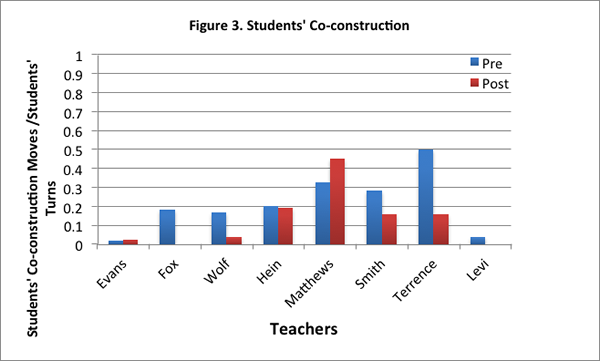
Further, students made more sense-making attempts in their turns at talk in the post-discussions than in the pre-discussions (see Figure 4). This pattern was observed in all six classes where we have both pre- and post-discussion data.
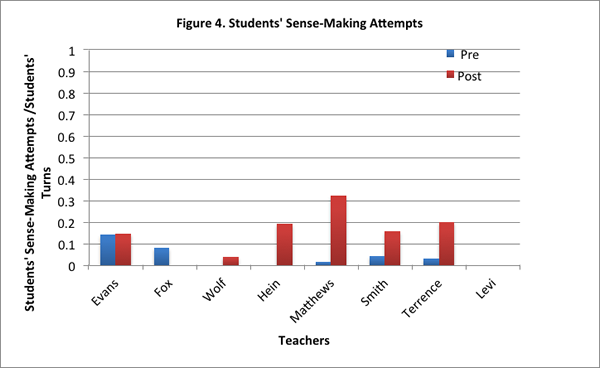
Upon a closer examination of students’ sense-making attempts in the post-discussions, we found that sense-making involved mainly proposing ideas for testing the competing claims presented in the concept cartoon. There were few instances of students generating new questions related to the science content, and revising their thinking in light of the discussion and their experiences. Figure 5 shows the proportion of students’ sense-making attempts involving proposing tests to determine the volume of the candles.
The elicitation of students’ ideas for testing the claims was part of the recommended question for this concept cartoon. More of students’ talk in the post-discussion than the pre-discussion involved proposing ideas to evaluate the competing claims. Whereas this is a positive finding that students generated ideas for testing claims more often in the post than in the pre discussions, an additional analysis of the extent to which the teachers prompted students to propose ideas for evaluating claims in the pre- and post-discussions may shed light on this finding. It is possible that teachers encouraged students to propose tests more often in the post-discussions than pre discussions. A preliminary examination suggests that in the pre-discussions, two of the teachers prompted students explicitly to discuss ways to test the concept cartoon ideas. In the post-discussions, on the other hand, all six teachers encouraged students explicitly to propose experiments to test the ideas. A further study of the discussions is needed to clarify the trend observed in students’ use of scientific moves.
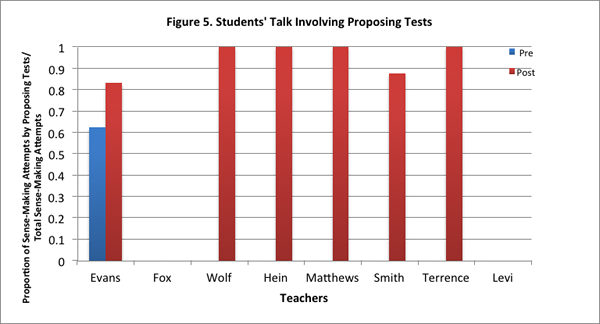
With respect to students’ turns involving proposing tests to determine the volume of candles, we examined also the extent to which the turns contained ideas based on the curriculum (see Figure 6). Figure 6 shows the proportion of turns involving ideas from the curriculum out of the total turns that presented tests to determine the volume of the candles. Specifically, the analysis identified the extent to which students applied ideas from the curriculum, such as water displacement, measuring the volume of liquids (liquid wax), using centimeter cubes for estimation, and measuring the weight in proposing tests to assess the competing claims presented in the concept cartoon. Ideas from outside the curriculum included using a mathematical formula to calculate volume of candles; reshaping the candles to make them comparable; determining the time taken to melt/burn the candle, etc.
Figure 6 indicates that in five of the six teachers’ classes, more than half of students’ proposed tests in the post-discussions contained ideas based on the curriculum than from outside the curriculum. This finding indicates that students tried to apply their understanding of the science from the curriculum while discussing the concept cartoon.
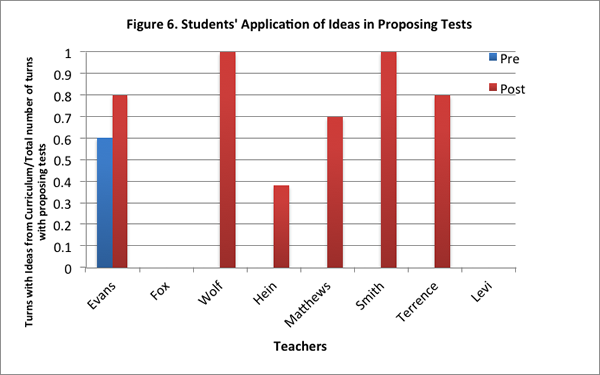
Looking across all the findings, the decrease in teachers’ use of the Think With Others moves and the general decrease in students’ co-construction moves are patterns that need to be examined further. The Think With Others moves were designed to facilitate students’ engagement with their peers’ ideas. One would expect that in the case of a judicious, strategic use of talk moves by a teacher, there would be less explicit prompting and support provided to the students to engage in particular discourse practices as the students begin to appropriate and display increasing fluency in the practices. The present analysis shows, however, that whereas teachers made less use of Think With Others moves, the students did not increase their attempts at co-construction. This finding points to the need to examine further the relationship between teachers’ use of talk moves and students’ participation in the discourse.



